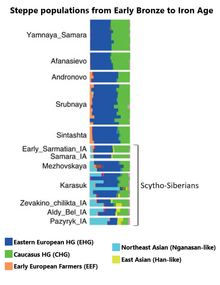Mezhovskaya culture
| Geographical range | Eurasian steppe |
|---|---|
| Period | Bronze Age |
| Dates | XIII cent. b.c. - VII cent. b.c. |
| Preceded by | the local variant Andronovo culture and Cherkaskul culture |
| Followed by | Itkul culture, Sauromatians |
The Mezhovskaya culture[1] (mistranscribed as Meshovskaya culture[2]) is an archaeological culture of the late Bronze Age (13th to the beginning of the 7th century BCE). It was localized in the Southern Urals and named after the village of Mezhovka on the banks of the Bagaryak river in the northern part of the Chelyabinsk Oblast.
The ancestors of the Mezhovskaya culture were the people of the Cherkaskul culture with the participation of the people of the Tobol taiga, with traditions and ceramics of the steppe zone of the Ural and Kazakhstan (Andronovo culture), especially the Sargarino-Alexis culture.[3]
The Mezhovskaya culture reflects the further stages of development of the Ugric community in active contact with the Indo-Iranian population of the Ural steppes.[4]
Archaeogenetics and origins
[edit]The Mezhovskaya culture formed from the admixture of local Srubnaya-like ancestry (c. 74%) with additional Nganasan-like (c. 18%) and Ancient North Eurasian (c. 8%) admixture. The later proto-Ugric genepool is inferred to have formed by further Eastern influc, resulting in a gene pool of c. 48% Srubnaya-like, c. 44% Nganasan-like and c. 8% ANE-like ancestry. It is thus considered that the Mezhovskaya culture was composed of a mixed population of Indo-European (Andronovo culture) and Ugrian (Cherkaskul culture) tribes.[5]

In 2015, a genetic study of ancient dwellings of the Mezhovskaya culture was made of people found at the Kapova Cave (Shulgan-tash). Three individuals (RISE523, RISE524, RISE525) of the Mezhovskaya in Southern Ural from 1400 BC to 1000 BC were studied.[6] The analysis of their paternal haplogroups determined one individual to belong to the haplogroup R1a1a1,[7] while the other two were determined to belong to R1b, which historians had thought were the result of migrations of early Indo-Europeans from the Black Sea to Siberia and Middle Asia via the Urals.[8][9]
The autosomal genetics does not seem to have died out, but contributed in part to the later Ugric-speaking groups.[10]
Stages
[edit]The Mezhovskaya culture developed through two stages:
- The Mezhovsky stage (13th-9th centuries b.c.)
- The Berezovsky stage (8th-7th century b.c.).[11]
The dwellings
[edit]Dwellings were excavated at Mezhovka, Kapova cave, Berezovka and other locations. The dwellings were unfortified with an area of 1 - 35 sq. m., and were more likely to occur in the forest-steppe of the Urals, and rarely in the Ural forests proper. The number of dwellings ranged from 1 to 10–15. They were usually shallow huts built with frame-pillar design.
The Mezhovsky culture had a diversified economy with a combination of production (especially cattle, metal) and assigns (hunting, fishing, gathering) forms of economy.
Cemeteries were small in size (up to 36 graves) and are found mainly in the forest-steppe regions of Bashkortostan. Most were composed of earthen mounds over elongated holes in the ground, with corpses on their backs with the head to the west-northwest. Cremation was rare. Equipment was often included in the graves, usually vessels, less often tools and weapons, and the remains of the funerary feasts.
The Mezhovsky culture exemplified the final phase of the Bronze Age of Ural forest zone and had a significant influence on the formation of the transition of the Ural cultures from the Bronze Age to the early Iron Age.[12]
References
[edit]- ^ Петрин В.Т., Нохрина Т.И., Шорин А.Ф. Археологические памятники Агразинского водохранилища (эпохи камня и бронзы). Новосибирск, 1993.
- ^ Morten E. Allentoft et al. «Population genomics of Bronze Age Eurasia»
- ^ Обыденнов М.Ф. Поздний бронзовый век Южного Урала. Уфа, 1986.
- ^ Петрин В.Т., Нохрина Т.И., Шорин А.Ф. Археологические памятники Агразинского водохранилища (эпохи камня и бронзы). Новосибирск, 1993.
- ^ Török, Tibor (2023-06-26). "Integrating Linguistic, Archaeological and Genetic Perspectives Unfold the Origin of Ugrians". Genes. 14 (7): 1345. doi:10.3390/genes14071345. ISSN 2073-4425. PMC 10379071. PMID 37510249.
- ^ Morten E. Allentoft, Martin Sikora, Karl-Göran Sjögren, Simon Rasmussen, Morten Rasmussen, Jesper Stenderup, Peter B. Damgaard, Hannes Schroeder, Torbjörn Ahlström, Lasse Vinner, Anna-Sapfo Malaspinas, Ashot Margaryan, Tom Higham, David Chivall, Niels Lynnerup, Lise Harvig, Justyna Baron, Philippe Della Casa, Paweł Dąbrowski, Paul R. Duffy, Alexander V. Ebel, Andrey Epimakhov, Karin Frei, Mirosław Furmanek, Tomasz Gralak, Andrey Gromov, Stanisław Gronkiewicz, Gisela Grupe, Tama´s Hajdu, Radosław Jarysz, Valeri Khartanovich, Alexandr Khokhlov, Vikto´ria Kiss, Jan Kola´rˇ, Aivar Kriiska, Irena Lasak, Cristina Longhi, George McGlynn, Algimantas Merkevicius, Inga Merkyte, Mait Metspalu, Ruzan Mkrtchyan, Vyacheslav Moiseyev, La´szlo´ Paja, Gyo¨rgy Pa´lfi, Dalia Pokutta, Łukasz Pospieszny, T. Douglas Price, Lehti Saag, Mikhail Sablin, Natalia Shishlina, Va´clav Smrcˇka, Vasilii I. Soenov, Vajk Szevere´nyi, Guszta´v To´th, Synaru V. Trifanova, Liivi Varul, Magdolna Vicze, Levon Yepiskoposyan, Vladislav Zhitenev, Ludovic Orlando, Thomas Sicheritz-Ponte´n, Søren Brunak, Rasmus Nielsen, Kristian Kristiansen & Eske Willerslev. «Population genomics of Bronze Age Eurasia»
- ^ Semargl.me
- ^ Косарев М.Ф. Бронзовый век Западной Сибири. М., 1981.
- ^ Генинг, В.Ф.; Зданович, Г.Б.; Генинг В.В.; [V.F.Gening; G.B.Zdanovich; V.V.Gening] (1992). Синташта: археологические памятники арийских племен Урало-Казахстанских степей [Sintashta: archaeological sites of the Aryan tribes of the Ural-Kazakhstan Steppe] (in Russian). Chelyabinsk: Южно-Уральское книжное изд-во. ISBN 5-7688-0577-X.
- ^ "We have also shown that a common ‘‘proto-Ugric’’ gene pool appeared in the Bronze Age from the admixture of Mezhovskaya and Nganasan people, supporting genetic and linguistic data" https://www.cell.com/current-biology/pdfExtended/S0960-9822(22)00732-1
- ^ Обыденнов М.Ф. Поздний бронзовый век Южного Урала. Уфа, 1986.
- ^ Сальников К.В. Очерки древней истории Южного Урала. М., 1967.

